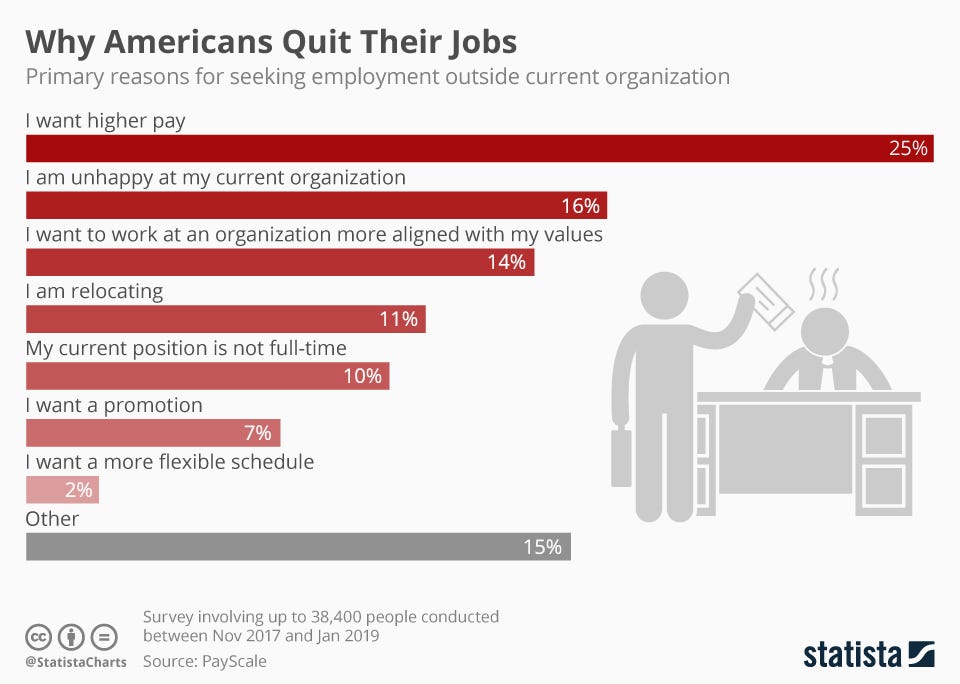Here’s the bad news for people working in jobs.
Global market forces for labor and advances in technology are suppressing salary and wage growth for most people.
The globalization of labor markets and impacts of technology have drastically weakened any policy interventions implemented by governments all around the world to directly increase their citizen’s salaries and wages and interfere with market forces. Even countries with low unemployment cannot effectively increase their workers’ salaries and wages.
There are also just too many job seekers going after a decreasing number of job vacancies. People have no choice but to take on any lower-paying jobs that they can grab on to. There are just not enough quality paying jobs to go around — hence, employers are very selective in who they hire and pay big bucks to.
This mismatch or gap between what job seekers have and what employers are looking for is ever-increasing. Job seekers and young people in particular are and will face significant challenges to break into the job market.
While there may be exceptions, many people will not experience any real salary growth especially when inflation, low-interest rates, and the increasing cost of living and healthcare are factored into the equation.
Global economic uncertainty
Businesses are operating in a world of economic uncertainty. This will impact on how employees and workers get paid and are being managed.
The global economic uncertainty index as shown below is based on newspaper coverage frequency including human readings of 12,000 newspaper articles indicates that the uncertainty around the world has significantly increased. It is even higher than the period of the global financial crisis.

Additionally, according to data compiled by the OECD, the global volume of foreign direct investment (FDI) fell 20% in the first half of 2019 compared to the previous half-year period. This decline accelerated in the second quarter when global FDI was down more than 40% from the previous quarter.
Zombie companies, or corporate underachievers overdosed on cheap credit, are proliferating across the globe, threatening to derail the weakening world economy, as shown in the diagram below.

The number of global organizations that do not generate sufficient profits to cover their interest payments and survive only by repeatedly refinancing their loans has doubled in a decade. It is only readily available low-cost debt financing helps keep highly indebted, poor-performing organizations alive that would have otherwise gone under.
Low wages impact spending, businesses, and lifestyles
In 1964, $2.50 could buy quite a bit. Now, this average hourly wage can only buy a pack of sweets.
Dollar for dollar, the average American worker’s hourly wage has risen nearly 10 times since 1964 to $22.65.
But here’s the kicker.
Although wages have steadily risen, so too has the cost of living.
In fact, compared to their 1964 counterparts, Americans’ real hourly wages have only increased by $2.38 (10.5%). This is despite sustained gains in productivity across all major industries. It means that the average American worker doesn’t have more cash to spend on essential goods and services.
This situation has been repeated in many industrialized countries.
It is no surprise that a survey found that 25% of workers are seeking employment outside their current organization because they want higher pay, as shown in the diagram below.

In a consumer economy, spending drives economic growth and increases the prosperity of businesses. The flow-on effect is a subdued economic growth, which is what a lot of countries are experiencing.
When real wages are stagnant, many consumers are going to either hold on to their money or look for the best deal possible. This could often mean turning to big businesses that leverage on economies of scale or lowering the retail price to the detriment of smaller businesses.
Why is this occurring?
Wage stagnation experienced over many years has been enabled by increasing global business competition, increasing population growth, technological advances, and an increasing number of educated job seekers.
Potentially, these same factors can reduce salaries and wages over time!
Governments all around the world can’t do much to interfere with global market forces and advances in technology by directly increasing salaries and wages. Instead, governments must create the right environment for businesses and individuals to be creative and find new ways of doing things to find growth and value.
The solution
New sources of opportunities, growth, and value creation are urgently needed to achieve stronger, more inclusive, and more sustainable development for governments, businesses, and workers.
The way to gain higher salaries and wages is to think creatively, develop new products and services, new jobs, new processes and methods, new ways of thinking and living, new enterprises, new sectors, new business models and new social models.
(This is a summary of the full article, which will be updated when new information and research are available.)


